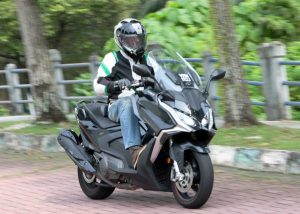PETALING JAYA: Honda Malaysia launched its first model of 2022 - the 11th-generation Civic - on Jan 13.
A day earlier, it organised a media group interview with Honda large project leader Tomoyuki Yamagami to enable him to offer some insights into the development of the latest Civic sedan.
Speaking through an interpreter, Yamagami addressed a barrage of questions from the Malaysian media in the online session as he spoke from Japan.
Here are some of the highlights of the interview.
Q1: Why isn't the new Civic getting the same output and torque as the Accord, which also uses a 1.5-litre turbocharged engine?
As a global model, the Civic specifications is based, on balance, on what the market demanded of this car. In this case, we answered the need for dynamic performance and at the same time fuel economy. Hence, the engine output/torque was lower than that of the Accord but still more than the one in the 10th-gen Civic.
Q2: Why is the Thailand Civic less powerful than the the one for Malaysia?
The difference boils down to the type of fuel used. Thailand uses E85 biofuel, while Malaysia uses normal petrol. (E85 is an 85% ethanol blend.)
Q3: What were the competitor models Honda benchmark the Civic against in terms of ride and handling?
The C-segment models we set it up against were the Toyota Corolla and Mazda3. Higher-segment models we look to were the Audi A3, A4 and VW Golf.

Yamagami in an online conference call with Malaysian media.
It uses ABS sensors in the wheels and the level of braking force to do that after traversing one or two corners.
Q5: The legroom remains unchanged despite the longer wheelbase in the new Civic. Why?
Honda's emphasis was not on extending legroom but rear seating comfort, which was an issue previously. The seatback is reclined 1 degree lower for better comfort. At the same time, the longer wheelbase was to improve stability and for the sake of better styling.
Q6: Were the suspension and steering settings altered for the new Civic?
Yes, there were some changes made. But the most important contributor to improving dynamic performance was to increase body rigidity; one way was to use more adhesives. Steering rigidity has also increased and we have widened the rear track for better stability.
Q7: If tyre size increases, will it alter the Electronic Stability Program (ESP) settings?
The ESP settings are optimised for each tyre size to provide that stable yet sporty feel. If tyre size increases, safety is still okay but ESP settings will not be ideal.
Q8: The CVT was more responsive than in the last generation. How was that achieved?
The Civic prototype had been tested extensively on roads in US, Germany and the UK. The focus was on improving the transmission response and feel. We achieved it through software calibration.
Q9: The LaneWatch camera continues to be offered for Asean but other markets get the blind spot detector. Why the disparity?
The choice of which equipment to use comes down to market conditions and infrastructural setup that differ from region to region.
In the region where Malaysia is, more motorcycles are being used, which the LaneWatch camera better captures.
Q10: The rear tail light design looks less radical than in the previous Civic. Was it to make it look more mature and appeal to a broader audience?
The Civic is a global model and aims for maximum appeal. As part of the design brief to minimise lines in the car and project an open feel with its wide glass area and low centre of gravity, the decision was made to offer this type of dynamic styling. The "laser brazing" technology to create a sleek roof is part of the overall design theme.
Q11: The 1.8-litre engine was dropped in the current Civic line-up. Why?
The answer is the need to comply with global emissions restrictions. In addition, the 1.8l engine is old tech. We decided to focus resources on the 1.5l VTEC Turbo engine.
READ MORE: New Honda Civic launched from RM125,600












